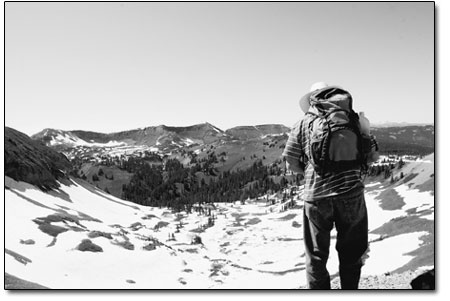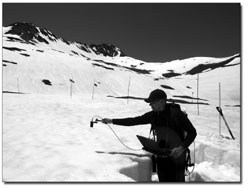| ||||
A dusty future
by Allen Best Everyone knows that snow is white, right? But if you dig a pit in the snow lingering during June high in the San Juan Mountains, you might decide it looks something more like an angel-food cake, but with layers of chocolate frosting. The chocolate frosting is dust, and research being conducted in a basin near Silverton finds that most of the dust there comes from the desert of the Colorado Plateau, particularly northwest New Mexico and northeast Arizona. In recent years, such dust storms have been observed three to eight times per year, mostly from February through May. In a study published in June in the journal Geophysical Research Letters, scientist Tom Painter finds that the dust at the San Juan location has, during the last several years, speeded melting of the snow anywhere from 18 to 35 days. While Painter’s research was conducted near Red Mountain Pass, the same storms have deposited dust from the Colorado Plateau in other ranges of the state, he says, although in lesser amounts. Unanswered questions The seed for the research was planted in 1998. Painter was climbing South Maroon Peak, a fourteener near Aspen, with his father, Richard J. Painter, a mathematics professor at Colorado State University in Fort Collins. It was late June, and there was still snow along the trail as they ascended the peak, but it was dirty snow. The younger Painter idly scraped the darker snow to leave a white surface, and left part of the darkened snow undisturbed. Father and son bagged the peak, ate their lunches, and in late afternoon returned past the thoughtless experiment. The darker snow had melted several more centimeters than the clean white snow. That was not particularly surprising. Dark absorbs solar radiation, while white reflect it, something called albedo. Snow has the greatest albedo of any material on the planet. But where did the dust come from? Painter, who was then studying in California, couldn’t answer the question nor other such questions. Nor did he try – until after he got his Ph.D. in 2002 and was working with the National Snow and Ice Data Center at the University of Colorado-Boulder. To conduct the experiment, he needed a relatively pristine place. It had to be away from obvious sources of air pollution, like smokestacks or roads, yet accessible for weekly visits. Painter’s search led him to Silverton, where he contracted with the Center for Snow and Avalanche Studies. Established by Chris Landry, the center is designed for scientists like Painter, who need assistance in studies involving snow in mountain locations. Landry had obtained permission from the U.S. Forest Service to conduct studies at a site called Senator Beck Basin. Named after a 19th century politician from Kentucky, the basin ranges in elevation from a little more than 11,000 feet to 13,321 feet. Changing the cycle Painter’s argument – partially relying on the work of others – is that the dust found on the snow of the San Juans is not necessarily natural. In fact, he says, disturbances in deserts of the Southwest have increased substantially in the last 140 years. In turn, the dust is melting the high-mountain snow up to a month early. The study has potentially large implications for the 35 million people dependent upon waters of the Colorado River and its tributaries. It is a river system driven by snowmelt, with 75 percent of all water arriving in the form of snow, mostly in the mountains. Reservoirs do tame the snowmelt cycle. Some 16 times the total annual flow of the river can be stored in reservoirs. More efficient, however, are the alpine snowbanks that, even into July, continue to melt in the high country. Lower-elevation reservoirs lose much water to evaporation. Already, virtually no water from the Colorado River gets into the Sea of Cortez, and most of what gets to Mexico is brackish and of poor quality. Global warming may well accentuate all this. Most climatologists believe that, regardless of whether the Southwest gets more precipitation or less in the future, hotter temperature will be pervasive. Those hotter temperatures, they say, will make the region drier, and drought-like conditions will quite possibly become the norm. If the deserts, their soils already disturbed, become more dry, they could unleash even more dust on the snowpack of the Rocky Mountains.
The dusts of spring How does Painter know where the dust comes from? First, satellite images allow scientists to see plumes rising from the desert and then moving toward the Rocky Mountains. Mostly, dust comes from nearby deserts, although some dust from Asia has been traced. Second, scientists can analyze the chemistry of the dust specimens, looking for chemical isotopes that can be traced to isotopes found in the bedrock of regions such as in northern Arizona. An expert in identifying these isotopic fingerprints is Jason Neff, a biogeochemist with the Geological Science Department at the University of Colorado-Boulder. The isotopes clearly tell the story. “With that information, we can say very definitely it’s not local,” he says. “It’s not from wood-burning, it‘s not road dust, and it’s not stuff flying off ridges from near the sample sites. It’s traveling into the state and being deposited on the snowpack.” It’s not possible, given current tools, to precisely pinpoint the source of the dust – say, for example, a location 20 miles from Flagstaff. But Neff and other scientists believe that relatively little of this dust is natural. A few small areas, such as the playas, or dry river beds and lakes, are natural sources of dust. But most of the dust is the result of soil disturbances. A study in Canyonlands National Park found a progressive loss of surface soil in areas that have been grazed by domestic livestock, as compared to areas that were not, says Neff, a participant in that study. “One-hundred years of grazing in the American Southwest, at least in that particular place in Utah, has led to a pretty large loss of soils,” he says. Neff is also conducting a study in the San Juans. In that study he is looking at core sediments taken from above-timberline lakes – including the dust that has been deposited. One goal is to determine whether the lake-bed sediments show a major change during the time of Euroamerican settlement. “We actually had a lot more grazing 100 years ago than we do now, although we now have more cars, home construction and recreational use” in the desert Southwest, he said. Neff hopes to publish his study results later this year. Desert dust isn’t natural From Moab, Jayne Belnap has also studied changes in the deserts of the Colorado Plateau. A soil scientist with the U.S. Geological Survey, she has used advanced equipment to simulate the effect of wind storms in the desert. The goal was to see what sticks and what flies. In most deserts, wind won’t pick up the soil, she says. In the American Southwest, the story largely is of disturbances – from livestock grazing, recreational vehicles and home construction. “Anything that has a compressional force. It doesn’t matter whether it’s a hoof, a bike, or an ATV or a tank – anything will disturb that surface,” she says. This is, she repeats, not normal. Desert soils will mostly stay put if they haven’t been disturbed. But the larger story here, she says, is of the altered hydrology caused by the vagrant dust in the Southwest. Even if the reservoirs can hold the flood waters of a rapid spring runoff, she says, the rhythm is changed. Among the water-quality problems will be increased sediment loading. Brad Udall, director of the Boulder-based Western Watershed Assessment, says he believes Painter’s study has not yet caused major eyebrow lifting among climate scientists. But water managers are paying attention. Flying from Denver to a water conference in Las Vegas during May, Udall remembers looking down on the mountains around Crested Butte and noticing how dirty the snow looked. “It’s certainly a wild card,” he says. “We need to know a lot more.” Although the study focuses on the interaction between the San Juan Mountains and the desert of the Colorado Plateau, Painter says he believes the research has implications for other places in the world where there are mountains and deserts in close proximity. •
|



